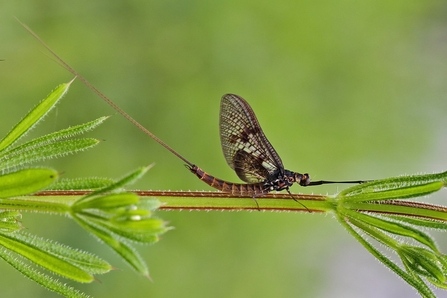
Common Mayfly ©Margaret Holland
Holly blue by Amy Lewis

Common Mayfly ©Margaret Holland
The name 'mayfly' is a slight misnomer as many mayflies can be seen all year-round, nevertheless, now is as good a time as any to spot them! The larvae spend their lives underwater, feeding on algae and plants. When they hatch out as adults, sometimes simultaneously and in their hundreds, they have very short lives – just hours in some cases.
During this time they display and breed, performing a mesmerising ‘dance’ as they flutter upwards before relaxing their wings and parachuting back down. Many species do not feed as adults as their sole purpose is to reproduce, dying once they have mated. Lashford Lane Fen near Abingdon is the perfect place to watch this life-and-death display!
A great crested grebe accompanied by its 'humbugs'
May is one of the most delightful times to visit your local waterbodies, as ducks, geese and swans will be accompanied by their newly-hatched fluffy chicks. Some of the most iconic of these are great crested grebelings, which ride on their mothers’ backs. They’re often dubbed ‘humbugs’ due to their black-and-white stripes resembling the classic boiled sweets.
The Nature Discovery Centre in Thatcham and College Lake near Tring are among the best places to see waterfowl in our three counties, with Great Crested Grebes also seen at the tranquil Cholsey Marsh near Wallingford.
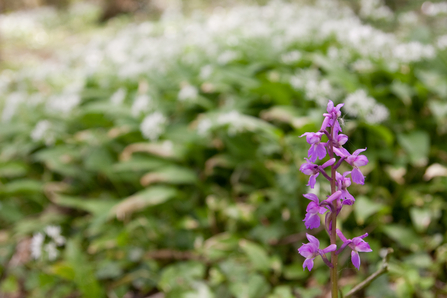
Photo by Vaughn Matthews
Early purple orchids are one of the first of the orchids to flower each year. They generally grow on limestone, particularly in woodland in amongst bluebells, or on grassland - but you may see them on road verges or alongside hedgerows too.
They have tall, purple flower spikes and spotted leaves, and, if you get close enough, an unpleasant musky or urine-like smell!
In our area you can see them in Bowdown Woods (Berks), Finemere Wood (Bucks), Moor Copse (Berks) and Sydlings Copse (Oxon).
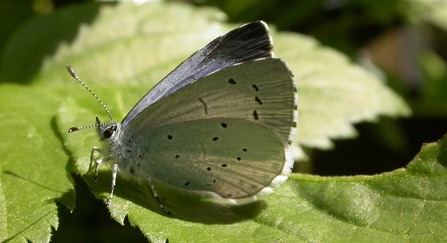
Holly blue © Philip Precey
Holly blues are now flying in our gardens and countryside. These small butterflies tend to fly high and quickly, so watch out of them as they zoom past. Despite their name they have a very white underwing and so can appear quite pale, rather than the brighter colour of the common blue, which isn’t yet on the wing.
The females lay their eggs on holly in spring, although they do use other plants, such as ivy, especially later in the season. To help these pretty little butterflies, try to keep some areas of your garden wilder, with ivy growing over trees and fences.
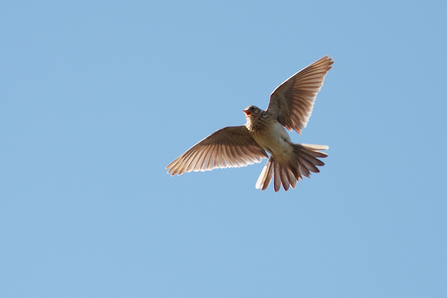
Skylark by Stefan Johansson
The song of the skylark has been the subject of many great musical and literary works. They hover effortlessly over farmland, grassland, saltmarshes and moorland, singing from a great height before parachuting back down to earth. These long and complicated song-flights can last for up to an hour and the birds can reach 300m before descending.
Despite their aerial activities, skylarks nest on the ground, laying three to four eggs. Heathland sites such as Greenham & Crookham Commons and Snelsmore Common near Newbury offer the perfect environment for these and other ground-nesting birds. However while a survey in 2009 recorded 32 male skylarks that had established nesting territories on Greenham Common, in 2024 there were just two. Sadly, this decline is partly down to disturbance by people and dogs, so if you do visit these special sites, please make sure you keep to the paths!
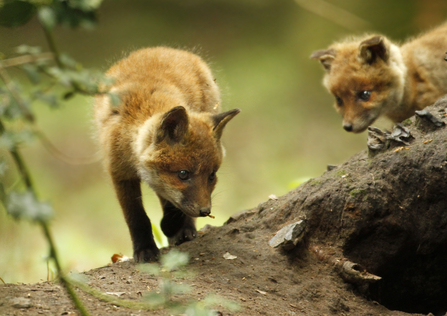
Photo by Jon Hawkins - Surrey Hills Photography
As May starts, most fox parents will still be foraging to feed their growing cubs, but the youngsters might start to accompany the adults on hunting expeditions, looking for small mammals such as mice, voles, weasels and rabbits. Although a lot of hunting happens at night, cubs can occasionally be spotted starting to explore their neighbourhoods in the daylight as well - so long as they don't suspect there are any humans about!
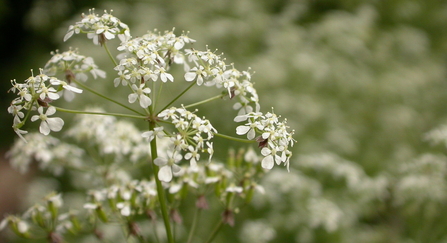
Cow parsley. Photo by Philip Precey
Cow parsley is a tall, fast-growing plant which decorates roadside verges with masses of frothy, white flowers and fern-like leaves over spring. Preferring to grow in shady areas, it can be commonly found in woodland edges and hedgerows and is attractive to a huge number of creatures, from orange-tip butterflies to marmalade flies, and even rabbits.
It is part of the Apiaceae family, more commonly known as umbellifers - a large family consisting of the celery, carrot and parsley variants of which there are over 3,000 species. Be careful not to confuse it with the poisonous hemlock, which is much bigger and can grow to around two metres!
A ground wolf spider
The wolf spider is a medium-sized spider that hunts on the ground during the day: it chases down its prey and leaps on it like a wolf. It frequents gardens and grasslands, as well as a variety of other habitats, and can often be seen sunbathing or running across the ground.
At this time of year, male wolf spiders start performing an intricate courtship dance to attract their mate, waving and vibrating their front legs. Look out for the males hunting for females on piles of rocks and logs.
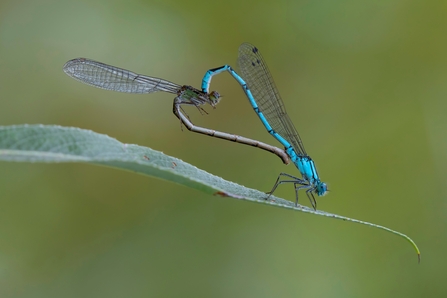
A common blue damselfly mating wheel by Jon Hawkins - Surrey Hills Photography
Living up to its name, the common blue damselfly is both very common and very blue. However, it’s easily mistaken for the very similar (and similarly common) azure damselfly, distinguished by a close examination of the black patterns on the abdomen – so bring your magnifying glass! It can be found around almost any waterbody, or away from breeding sites in grassland and woodland.
As with other damselflies, when common blues mate they form a 'mating wheel' in which the male clasps the female by the neck and she bends her body around to his reproductive organs.
Common Tern (https://vimeo.com/444192856)
Common Tern by Tom Hartwell
Common terns join us in spring and summer to breed on shingle beaches, rocky islands and inland on the gravelly shores of lakes and rivers. They are noisy in their colonies and, like most terns, will attack intruders threatening their nests. They hover over the water before plunge-diving to catch their fish prey.
At several of our reserves, purpose-built rafts acting as floating islands encourage these graceful birds to nest in safety, away from local foxes. Look for them at Calvert Jubilee, east of Bicester, as well as the Nature Discovery Centre in Thatcham and College Lake near Tring.